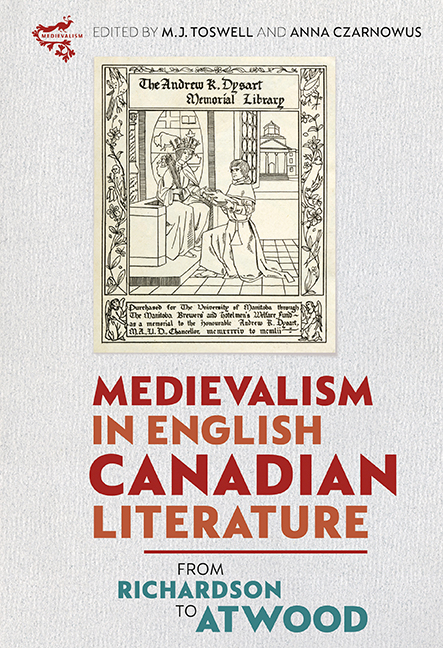Book contents
- Frontmatter
- Contents
- Introduction: English Canadian Medievalism
- 1 “Men of the North”: Archibald Lampman's Use of Incidents in the Lives of Medieval Monarchs and Aristocrats
- 2 “Going Back to the Middle Ages”: Tracing Medievalism in Julia Beckwith Hart's St. Ursula's Convent and John Richardson's Wacousta
- 3 John Richardson's Wacousta and the Transfer of Medievalist Romance
- 4 A Canadian Caliban in King Arthur's Court: Materialist Medievalism and Northern Gothic in William Wilfred Campbell's Mordred
- 5 Orientalist Medievalism in Early Canadian Periodicals
- 6 The Collegiate Gothic: Legitimacy and Inheritance in Robertson Davies's The Rebel Angels
- 7 Earle Birney as Public Poet: a Canadian Chaucer?
- 8 “That's what you get for being food”: Margaret Atwood's Symbolic Cannibalism 129
- 9 Lost in Allegory: Grief and Chivalry in Kit Pearson's A Perfect, Gentle Knight
- 10 Remembering the Romance: Medievalist Romance in Fantasy Fiction by Guy Gavriel Kay and Charles de Lint
- 11 Medievalisms and Romance Traditions in Guy Gavriel Kay's Ysabel
- 12 The Medieval Methods of Patrick DeWitt: Undermajordomo Minor
- Index
- Miscellaneous Endmatter
2 - “Going Back to the Middle Ages”: Tracing Medievalism in Julia Beckwith Hart's St. Ursula's Convent and John Richardson's Wacousta
Published online by Cambridge University Press: 25 March 2020
- Frontmatter
- Contents
- Introduction: English Canadian Medievalism
- 1 “Men of the North”: Archibald Lampman's Use of Incidents in the Lives of Medieval Monarchs and Aristocrats
- 2 “Going Back to the Middle Ages”: Tracing Medievalism in Julia Beckwith Hart's St. Ursula's Convent and John Richardson's Wacousta
- 3 John Richardson's Wacousta and the Transfer of Medievalist Romance
- 4 A Canadian Caliban in King Arthur's Court: Materialist Medievalism and Northern Gothic in William Wilfred Campbell's Mordred
- 5 Orientalist Medievalism in Early Canadian Periodicals
- 6 The Collegiate Gothic: Legitimacy and Inheritance in Robertson Davies's The Rebel Angels
- 7 Earle Birney as Public Poet: a Canadian Chaucer?
- 8 “That's what you get for being food”: Margaret Atwood's Symbolic Cannibalism 129
- 9 Lost in Allegory: Grief and Chivalry in Kit Pearson's A Perfect, Gentle Knight
- 10 Remembering the Romance: Medievalist Romance in Fantasy Fiction by Guy Gavriel Kay and Charles de Lint
- 11 Medievalisms and Romance Traditions in Guy Gavriel Kay's Ysabel
- 12 The Medieval Methods of Patrick DeWitt: Undermajordomo Minor
- Index
- Miscellaneous Endmatter
Summary
”IT IS LIKE going back to the Middle Ages,” says minister Howitt, the protagonist of Lily Dougall's short story “Witchcraft,” commenting on the local belief in Cape Breton that witches spoil cows’ milk. This single mention of the medieval in the story suddenly brings a version of dark Old-World history – not so much infested by witches as, worse still, inhabited by people who believe such nonsense – straight into a late nineteenth-century modern, and yet obviously superstitious, Canadian town. As Cynthia Sugars observes, early Canadian literary discourse is permeated by a sense of lack – there is in Canada nothing that is medieval or spiritual: no decayed castle, no ghost. Still, as she argues, Gothicism, rooted in a fascination with the medieval, is ever-present in the Canadian cultural and literary experience.
In her study, Sugars is concerned with the historical circumstances that accompanied the shaping of national identity in Canada and which coincided with the Gothic vogue in Britain and on the European continent. Somewhat paradoxically, these circumstances had to do largely with a perceived lack of the nation's own history, a basis upon which Canadians could found and define their nationhood and literature. As she writes, white settlers in Canada are “positioned as disinherited descendants of a Gothic past” (52), the country being at once too young to have been through an “ancient” and ghost-haunted phase of development, and spiritually too old, too progressive and too rational now to still undergo such a phase (53). As a result, early Canadian authors take recourse in Gothicism as particularly suitable for expressing their experience as well as producing and preserving the missing past. The Gothic romance serves to provide both credentials – representing a cultural-literary phase that, though critically unacclaimed, must be completed – and a “distant” history that the young Canada apparently lacks, whether it be projected on Quebec or on Nova Scotia (49–143). In so doing, it must be noted, early Canadian writers also effectively work to make medievalism a global phenomenon, partaking in the constant process of reinventing the Middle Ages in ways that suit present needs.
The present project is concerned with early nineteenth-century Canadian Gothic, and thus with medievalism as transferred into Canadian literature by way of Gothicism.
- Type
- Chapter
- Information
- Medievalism in English Canadian LiteratureFrom Richardson to Atwood, pp. 36 - 51Publisher: Boydell & BrewerPrint publication year: 2020



